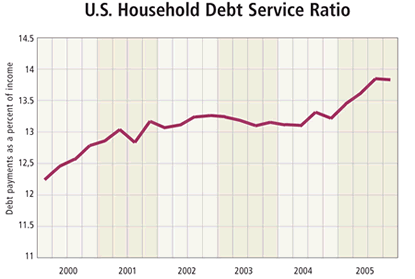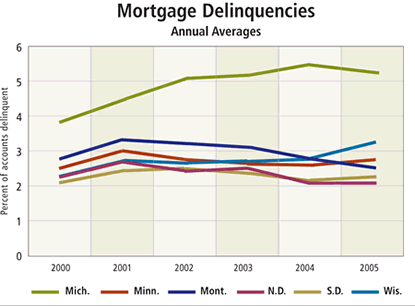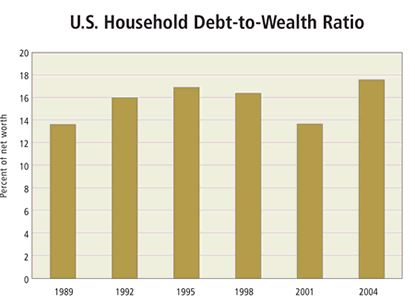Money isn't as cheap as it used to be. Two years ago, with the federal funds rate sitting at 1 percent, it's no surprise that the recovery from the last recession was led by consumer spending. Partly as a result, American families now hold more debt than at any time in history.
But since June 2004, the Federal Reserve has raised its interest rate target 16 times in a row, and still more rate hikes may lie ahead. Yet consumers have continued borrowing, and the demand has further pushed up interest rates for an array of loans. Borrowing habits in the region closely parallel national trends.
What's intriguing about the public's appetite for personal debt is that as the ratio of debt payments to income has climbed steadily since the end of the recession, the overall rate of loan delinquency has fallen. Given the run-up in interest rates, and the fact that wages and job growth have lagged behind overall economic growth during the recovery, this is something of a puzzle. Consumers are paying more to carry extra debt with only slightly bigger incomes, yet their payment track record is getting better, not worse.
Meanwhile, as consumer-loan delinquency has dropped, the delinquency rate for mortgage and home equity loans started increasing in the second half of last year. Some analysts have pointed to this as a warning sign, saying that delinquencies on other forms of debt may also rise, destabilizing the economy. A credit bust is unlikely, however. Borrowing is showing signs of leveling off. And the discrepancy between delinquency rates for consumer loans and those for mortgages will probably disappear as a variety of economic factors conspire to drive up delinquencies, repossessions and foreclosures.
Just charge it
The reason debt has run up so much recently is straightforward: People like to spend money now that they won't have until later. For most of the post-recession recovery, debt has increased faster than income.

Source: Federal Reserve Board
Economists refer to the phenomenon of consumers borrowing when young and repaying later in life as "consumption smoothing." The practice allows people with growing incomes to even out their consumption over the course of their lives. Along with higher demand and lower interest rates, the "democratization of credit" that began in the 1990s as banks offered credit cards to greater numbers of lower-income households has contributed to credit use. Since the third quarter of 2000, according to the Federal Reserve Board of Governors, most lenders have eased approval standards for credit cards as well as other types of loans.
But higher-income earners have contributed more to credit usage than those at the lower end of the income scale. "It looks like the top 20 percent [of borrowers] are the ones who have increased their debt," said David Land, a portfolio manager at Advantus Capital, an investment management firm in St. Paul. Affluent consumers have seen their income rise much faster than that of the rest of the population, and they're spending that income on big-ticket items typically purchased with credit.
A run-up in housing values in Ninth District markets, as well as nationwide, has also fueled increases in borrowing. Low mortgage interest rates over the past five years sustained a wave of home buying, which in turn increased consumer spending as homeowners borrowed against some of their new equity to purchase goods to fill those houses.
In fact, growth in the use of credit cards and most types of installment credit (such as personal loans) has been slow in comparison with a surge in real-estate-financed borrowing through second mortgages and home equity loans, said Keith Leggett, a senior economist with the American Bankers Association in Washington, D.C. The proliferation of new kinds of revolving credit based on real estate has encouraged this reliance on equity as a financing tool. The most prominent of these new financial products is the home equity line of credit, which works like a credit card backed by real estate as collateral.
Financial deadbeats: A dying breed?
With borrowing increasing, interest rates up and banks relaxing their credit-approval standards, one might expect more borrowers to miss their monthly payments. But that hasn't happened.

Source: Federal Reserve Bank of Minneapolis
In most district states, delinquencies on installment loans decreased in the fourth quarter of 2005 from the same period a year earlier, according to data from the American Bankers Association. In Minnesota, the percentage of delinquent accounts dropped 41 percent. Trends were similar for a variety of loans, including credit cards. (Delinquency rates are measured by both share of accounts and dollar value. The value of delinquent accounts is down more than the number of delinquent borrowers, even though the volume of overall debt is up.)
Overall, the district picture mirrors the national trend. Exceptions include South Dakota, where some banks take advantage of an absence of state-mandated interest-rate caps to deal in high-interest, out-of-state loans, and Michigan, where the economy is suffering from manufacturing layoffs.
In contrast, delinquency rates for mortgages and real-estate-backed loans have inched up nationwide since mid-2005. Rates in some district states—Montana, for example—declined, but in general, they follow the national trend, with Michigan performing worst (see chart).

Source: Mortgage Bankers Association
At first blush, a rising mortgage delinquency rate is difficult to reconcile with a slowdown in consumer-loan delinquency. Understanding this inconsistency requires a closer look at the characteristics of the two markets.
Debt you can afford (or maybe not)
The primary factor pushing down consumer-loan delinquencies has been economic growth in the past two years. Incomes have grown the fastest for higher earners, so those consumers have the means to make good on their mounting debts.
Soaring home values haven't just gone to finance more consumption. Owners of appreciating homes also took the opportunity to pay off some outstanding debt with lower-interest home equity loans and second mortgages.
A relative easing in gasoline prices after the big spike in the wake of Hurricane Katrina last year also helped free up more cash that consumers used to cover their obligations.
Finally, the downward trend in consumer-loan delinquencies was reinforced by a surge in personal bankruptcies at the end of last year, nationally and regionally. A change in federal bankruptcy laws last fall induced many people living on the margin to shed their debts while they had the chance. Since many of these borrowers would have gone delinquent had they remained solvent, the bankruptcy rush reduced delinquency numbers in the last quarter of 2005, and into 2006.
As for rising mortgage delinquency rates, the countertrend that some analysts view as a harbinger of instability has a less ominous interpretation. Scott Anderson, senior economist at Wells Fargo in Minneapolis, noted that homeowners receiving federal housing assistance and those carrying higher-risk sub-prime mortgages started to buy in greater numbers near the end of the housing boom. That pushed the overall mortgage delinquency rate up, since those borrowers are more likely to miss payments. Also, in contrast to the credit card sector, where delinquency rates dropped from relatively high levels, the uptick in mortgage delinquencies came on the heels of historically low rates over the past several years.
Buy now! No payments 'til …
With delinquency rates for most types of debt heading south and Americans continuing to borrow in the face of rising interest rates, it's possible that this rosy scenario will continue indefinitely.
How much people borrow is determined by their wealth, not just their income. While debt payments have risen faster than incomes, the ratio of total debt to wealth for different income levels is in line with historical norms, according to the Fed's tri-annual Survey of Consumer Finances (see chart).

Source: Federal Reserve Board
Rapid growth in consumer wealth across all income categories kept debt-to-wealth ratios steady while debt payments outstripped incomes. This is why current levels of debt may be sustainable. The increase in borrowing has been fueled by even faster growth in consumer wealth, particularly home equity, and new financial products allow people to tap into that wealth, largely inaccessible in the past.
But some analysts say that the pace of borrowing will finally level off while delinquencies—on both the consumer and real estate side—gradually increase. Anderson, of Wells Fargo, sees 2006 as a transitional year. He points out that 60 percent of existing adjustable-rate mortgages will be repriced this year, likely by several percentage points; when those rate increases kick in, they'll drive up delinquency rates.
Many of the latecomers to the housing boom bought in at low, adjustable "teaser" rates, and they are typically the borrowers least able to afford big increases in their mortgage payments. According to Fannie Mae, a major mortgage financing corporation, 90 percent of sub-prime mortgages taken out in 2004 were at adjustable rates. Twenty percent of sub-prime borrowers are paying only interest on new mortgages and effectively have no equity, and 30 percent hold simultaneous second mortgages. Next year, Anderson expects the rate of home foreclosures, currently comfortably low, to start to climb as rising interest rates tighten the screws on low-income homeowners with little equity.
Home equity borrowers are also likely to experience "sticker shock" this year, said Leggett, of the American Bankers Association. This will probably reduce reliance on real-estate-financed consumer borrowing, making other types of consumer loans, including credit cards, look more attractive again. While credit card delinquencies declined from year-earlier levels at the end of 2005, they are higher overall than they typically have been in this decade. Leggett thinks the market may have hit a new plateau, where delinquency rates hover higher than they have in the past, in large part because of increased access to plastic by lower-income households.
With home prices likely to moderate, borrowers shouldn't get much more mileage out of their equity. And with higher interest rates, coupled with debt service ratios at an all-time high, it's hard to see borrowers running up higher credit card balances. Consumer lending is likely to level off, along with mortgage activity.
No cause for panic
The pressure of ballooning interest rates is highest on people at the margins with low incomes. No amount of analysis can console those suffering through financial difficulties, but the effect on the economy as a whole probably won't be too severe. "About $320 billion is at risk here," said Anderson, referring to sub-prime, adjustable-rate mortgages. "That's a relatively small portion of the overall mortgage market, which is now at $8.7 trillion."
Further, while these figures may alarm observers, the people approving loans aren't surprised. Any additional risk taken on by a financial institution is figured into the interest paid on the loan, so it's unlikely that any major lender will go belly up because of escalating delinquency.
Compared with economic fundamentals, the impact of interest rates on consumer finances is tiny. Job security and pay levels are much more vital to personal financial security than APRs, so climbing employment and income should outweigh higher interest rates as long as rates don't rise so much that they retard growth.
"I actually take it as a good sign that the Fed has been raising interest rates," Leggett said. When the Fed sees fit to hike interest rates, it means that the economy is growing. In a growing economy, people have jobs, and the income necessary to pay their debts.
Joe Mahon is a Minneapolis Fed regional outreach director. Joe’s primary responsibilities involve tracking several sectors of the Ninth District economy, including agriculture, manufacturing, energy, and mining.





